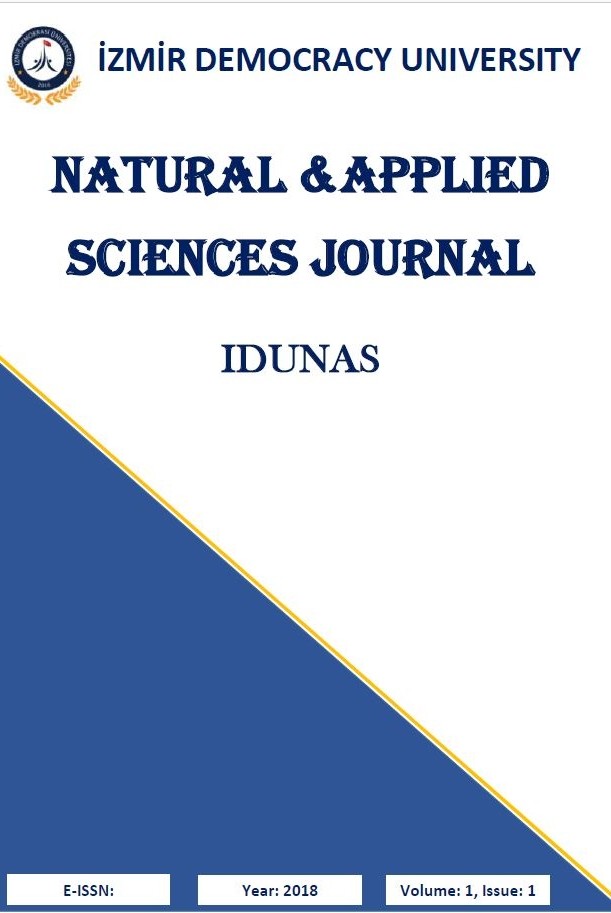The Effect of Plasma Treatment Parameters on Antibacterial and Antifungal Activity of Plasma Polymerized Diethyl Phosphite Thin Films
The Effect of Plasma Treatment Parameters on Antibacterial and Antifungal Activity of Plasma Polymerized Diethyl Phosphite Thin Films
Plasma polymerization, Amphoteric polymer, Titanium, Antimicrobial coating, Fungicidal activity, Antibacterial activity,
___
- 1. Holzapfel, B. M., Reichert, J. C., Schantz, J. T., Gbureck, U., Rackwitz, L., Nöth, U., ... & Hutmacher, D. W. (2013). How smart do biomaterials need to be? A translational science and clinical point of view. Advanced drug delivery reviews, 65(4), 581-603.
- 2. Donlan, R. M. (2002). Biofilms: microbial life on surfaces. Emerging infectious diseases, 8(9), 881.
- 3. Meyer, B. (2003). Approaches to prevention, removal and killing of biofilms. International biodeterioration & biodegradation, 51(4), 249-253.
- 4. Høiby, N., Ciofu, O., Johansen, H. K., Song, Z. J., Moser, C., Jensen, P. Ø., ... & Bjarnsholt, T. (2011). The clinical impact of bacterial biofilms. International journal of oral science, 3(2), 55-65.
- 5. Swartjes, J. J., Sharma, P. K., Kooten, T. G., van der Mei, H. C., Mahmoudi, M., Busscher, H. J., & Rochford, E. T. (2015). Current developments in antimicrobial surface coatings for biomedical applications. Current Medicinal Chemistry, 22(18), 2116-2129.
- 6. Yasuda, H., & Gazicki, M. (1982). Biomedical applications of plasma polymerization and plasma treatment of polymer surfaces. Biomaterials, 3(2), 68-77.
- 7. Tang, Z., Kong, N., Ouyang, J., Feng, C., Kim, N. Y., Ji, X., ... & Tao, W. (2020). Phosphorus science-oriented design and synthesis of multifunctional nanomaterials for biomedical applications. Matter, 2(2), 297-322.
- 8. Akdogan, E., Demirbilek, M., Sen, Y., Onur, M. A., Azap, O. K., Sonmez, E., ... & Mutlu, M. (2019). In vitro and in vivo bacterial antifouling properties of phosphite plasma-treated silicone. Surface Innovations, 7(2), 122-132.
- 9. Kaleli-Can, G., Özgüzar, H. F., Kahriman, S., Türkal, M., Göçmen, J. S., Yurtçu, E., & Mutlu, M. (2020). Improvement in antimicrobial properties of titanium by diethyl phosphite plasma-based surface modification. Materials Today Communications, 25, 101565.
- 10. Kaleli-Can, G., Hortaç-İştar, E., Özgüzar, H.F., Mutlu, M., Mirza, H.C., Başustaoğlu, A., Göçmen, J.S. (2020) Prevention of Candida biofilm formation over polystyrene by plasma polymerization technique. MRS Communications.
- 11. Elias, C. N., Lima, J. H. C., Valiev, R., & Meyers, M. A. (2008). Biomedical applications of titanium and its alloys. Jom, 60(3), 46-49.
- 12. Özcan, M., & Hämmerle, C. (2012). Titanium as a reconstruction and implant material in dentistry: advantages and pitfalls. Materials, 5(9), 1528-1545.
- 13. JIS, Z. (2000). 2801: 2000 Antimicrobial Products-Test for Antimicrobial Activity and Efficacy. Japanese Standards Association, Akasaka, Minato-ku, Japan.
- 14. Yurtcu, E., İşeri, Ö. D., & Sahin, F. I. (2014). Genotoxic and cytotoxic effects of doxorubicin and silymarin on human hepatocellular carcinoma cells. Human & experimental toxicology, 33(12), 1269-1276.
- 15. Occhiello, E., Morra, M., Cinquina, P., & Garbassi, F. (1992). Hydrophobic recovery of oxygen-plasma-treated polystyrene. Polymer, 33(14), 3007-3015.
- 16. Behnisch, J., Holländer, A., & Zimmermann, H. (1993). Factors influencing the hydrophobic recovery of oxygen-plasma-treated polyethylene. Surface and Coatings Technology, 59(1-3), 356-358.
- 17. Della Volpe, C., Fambri, L., Fenner, R., Migliaresi, C., & Pegoretti, A. (1994). Air-plasma treated polyethylene fibres: effect of time and temperature ageing on fibre surface properties and on fibre-matrix adhesion. Journal of materials science, 29(15), 3919-3925.
- 18. Jensen, C., Zhang, C., & Qiu, Y. (2003). The aging of atmospheric plasma-treated ultrahigh-modulus polyethylene fibers. Composite Interfaces, 10(2-3), 277-285.
- 19. Lawton, R. A., Price, C. R., Runge, A. F., Doherty III, W. J., & Saavedra, S. S. (2005). Air plasma treatment of submicron thick PDMS polymer films: effect of oxidation time and storage conditions. Colloids and Surfaces A: Physicochemical and Engineering Aspects, 253(1-3), 213-215.
- 20. Siow, K. S., Britcher, L., Kumar, S., & Griesser, H. J. (2014). Deposition and XPS and FTIR analysis of plasma polymer coatings containing phosphorus. Plasma Processes and Polymers, 11(2), 133-141.
- ISSN: 2645-9000
- Başlangıç: 2018
- Yayıncı: İzmir Demokrasi Üniversitesi
Başak DALBAYRAK, Ekin SÖNMEZ, Habibe KURT, Müge İŞLETEN HOŞOĞLU, İsrafil KÜÇÜK, Hale SAYBAŞILI, Işıl KURNAZ
Automatic Assessment of Human Sperm Images with Capsule Networks
Ultrasound Signals For Temperature Measurement In a Tissue Model
Atakan ACAR, Gizem KALELİ CAN, Mustafa KOCAKULAK
Nerve Guidance Conduits for Spinal Cord Injury
Multi-Sensor Glove Design and Bio-Signal Data Collection
